The Effect of Using Reactive Agility Exercises with the FITLIGHT Training System on the Speed of Visual Reaction Time and Dribbling Skill of Basketball Players
Abstract
1. Introduction
2. Materials and Methods
2.1. Experimental Approach to the Problem
2.2. Ethical Considerations
2.3. Tools and Devices
2.4. Procedures
2.4.1. Procedures to Implement Program Using FITLIGHT
- -
- The duration of the training program was 8 weeks.
- -
- There were 4 modules per week.
- -
- Special workouts similar to the dribbling skill performance of basketball players were selected.
- -
- The reactive agility training began after warm-up and at the beginning of the main part of the training unit, since it placed a heavy burden on the central nervous system. This required complete preparation without fatigue.
- -
- The reactive agility training within the training module took between 35 and 45 min.
- -
- Breaks between workouts (1–2 s) and between groups (2–4 s) were allowed to avoid fatigue and overload.
- -
- All players were exposed to a constant warm-up for 15 min before execution.
- -
- The researchers took into account reactive breaks between exercises.
- -
- The researchers used load intensity (less than maximum intensity–maximum intensity).
- -
- The training method used over the period was high intensity.
- -
- The number of duplicates was 2–8.
- -
- The number of groups was 2–3.
- -
- The rest between groups was 2–4 min.
- -
- All exercises were performed at the highest speed possible for the individual.
- -
- All exercises were combined with forms of play.
- -
- Training first took place in simplified conditions and then the difficulty was gradually increased, simulating opponent time pressure.
- -
- The diversity of exercises was as high as possible to maximize individual success experiences.
| Weeks | 1 | 2 | 3 | 4 | 5 | 6 | 7 | 8 |
|---|---|---|---|---|---|---|---|---|
| Stages | General Preparation Phase | Special Preparation Phase | Competition Preparation Phase | |||||
| Maximum |  |  |  | |||||
| High |  |  |  | |||||
| minimum |  |  | ||||||
| Weekly Time | 320 min | 400 min | 480 min | 400 min | 320 min | 480 min | 480 min | 400 min |
| Total Time | 720 min | 1680 min | 880 min | |||||
| Total Program Time | 3280 min | |||||||
| Stage | Weeks | Severity | Days | Warm-Up | Reactive Agility Training | Groups | Repeats | Comfort | Final | |||||
|---|---|---|---|---|---|---|---|---|---|---|---|---|---|---|
| B Exercises | B Groups | |||||||||||||
| Pre-Trial | Week 1 | 60% | Saturday | Exercises to prepare the body and extensions | 1 | 2 | 3 | 4 | 5 | 2 | Between 2:8 repeat, 2:3 sets according to stage and load intensity | 70 s | 2 min | Calming exercises |
| Sunday | 7 | 8 | 9 | 10 | 11 | 3 | 70 s | 2 min | ||||||
| Tuesday | 6 | 2 | 4 | 5 | 8 | 3 | 75 s | 2 min | ||||||
| Thursday | 13 | 14 | 1 | 2 | 3 | 3 | 70 s | 2 min | ||||||
| Week 2 | 65% | Saturday | 5 | 6 | 7 | 8 | 9 | 3 | 70 s | 2 min | ||||
| Sunday | 11 | 12 | 13 | 14 | 1 | 3 | 80 s | 2 min | ||||||
| Tuesday | 6 | 8 | 9 | 10 | 11 | 3 | 80 s | 2 min | ||||||
| Thursday | 3 | 4 | 5 | 6 | 7 | 2 | 70 s | 2 min | ||||||
| Special Preparation | Week 3 | 70% | Saturday | 9 | 10 | 11 | 12 | 13 | 3 | 75 s | 2 min | |||
| Sunday | 1 | 2 | 3 | 4 | 5 | 3 | 70 s | 2 min | ||||||
| Tuesday | 13 | 14 | 1 | 2 | 3 | 2 | 70 s | 3 min | ||||||
| Thursday | 7 | 8 | 9 | 10 | 11 | 3 | 80 s | 3 min | ||||||
| Week 4 | 75% | Saturday | 13 | 14 | 1 | 2 | 3 | 3 | 80 s | 3 min | ||||
| Sunday | 5 | 6 | 7 | 8 | 9 | 3 | 75 s | 3 min | ||||||
| Tuesday | 15 | 16 | 17 | 18 | 19 | 2 | 70 s | 3 min | ||||||
| Thursday | 11 | 12 | 13 | 14 | 1 | 3 | 70 s | 3 min | ||||||
| Week 5 | 75% | Saturday | 3 | 4 | 5 | 6 | 7 | 3 | 80 s | 3 min | ||||
| Sunday | 9 | 10 | 11 | 12 | 13 | 3 | 80 s | 3 min | ||||||
| Tuesday | 15 | 16 | 17 | 18 | 19 | 2 | 75 s | 3 min | ||||||
| Thursday | 1 | 2 | 3 | 4 | 5 | 3 | 70 s | 3 min | ||||||
| Week 6 | 80% | Saturday | 7 | 8 | 9 | 10 | 11 | 3 | 70 s | 3 min | ||||
| Sunday | 13 | 14 | 1 | 2 | 3 | 3 | 80 s | 3 min | ||||||
| Tuesday | 15 | 16 | 17 | 18 | 19 | 2 | 80 s | 3 min | ||||||
| Thursday | 5 | 6 | 7 | 8 | 9 | 3 | 75 s | 3 min | ||||||
| Week 7 | 80% | Saturday | 11 | 12 | 13 | 14 | 1 | 3 | 70 s | 3 min | ||||
| Sunday | 3 | 4 | 5 | 6 | 7 | 3 | 70 s | 3 min | ||||||
| Tuesday | 15 | 16 | 17 | 18 | 19 | 2 | 80 s | 3 min | ||||||
| Thursday | 9 | 10 | 11 | 12 | 13 | 3 | 80 s | 3 min | ||||||
| Week 8 | 85% | Saturday | 1 | 2 | 3 | 4 | 5 | 3 | 75 s | 3 min | ||||
| Sunday | 15 | 16 | 17 | 18 | 19 | 3 | 70 s | 3 min | ||||||
| Tuesday | 13 | 14 | 1 | 2 | 3 | 2 | 70 s | 3 min | ||||||
| Thursday | 7 | 8 | 9 | 10 | 20 | 3 | 80 s | 3 min | ||||||
2.4.2. Testing Procedures
2.5. Statistical Analysis
3. Results
4. Discussion
5. Conclusions
Author Contributions
Funding
Institutional Review Board Statement
Informed Consent Statement
Data Availability Statement
Acknowledgments
Conflicts of Interest
Appendix A. Modified Agility t-Test and Modified Agility t-Test (Dribbling Skill)
Appendix B. Visual Reaction Time Test
Appendix C
References
- Zou, L. Relationship between functional movement screening and skill-related fitness in college students. Age 2016, 20, 11–18. [Google Scholar]
- Irandoust, K.; Jami, S. Improving agility performance among athletes by Jami Agility Table (JAT). Int. J. Sport Stud. Health 2022, 5, e128414. [Google Scholar] [CrossRef]
- Lyons, M.; Al-Nakeeb, Y.; Nevill, A. The Impact of moderate and high intensity total body fatigue on passing accuracy in expert and novice basketball players. J. Sports Sci. Med. 2006, 5, 215–227. [Google Scholar] [PubMed]
- Refoyo, I.R.; Sampedro, J.M.; Sillero, M.Q. The relationship between exercise intensity and performance in drills aimed at improving the proficiency, technical and tactical skills of basketball players. Rev. Int. Cienc. Deport. 2009, 5, 1–10. [Google Scholar] [CrossRef]
- Vencúrik, T.; Nykodým, J.; Bokůvka, D.; Rupčić, T.; Knjaz, D.; Dukarić, V.; Struhár, I. Determinants of dribbling and passing skills in competitive games of women’s basketball. Int. J. Environ. Res. Public Health 2021, 18, 1165. [Google Scholar] [CrossRef]
- O’Grady, C.J.; Dalbo, V.J.; Teramoto, M.; Fox, J.L.; Scanlan, A.T. External workload can be anticipated during 5 vs. 5 games-based drills in basketball players: An exploratory study. Int. J. Environ. Res. Public Health 2020, 17, 2103. [Google Scholar] [CrossRef]
- Stojanović, E.; Stojiljković, N.; Scanlan, A.T.; Dalbo, V.J.; Berkelmans, D.M.; Milanović, Z. The activity demands and physiological responses encountered during basketball match-play: A systematic review. Sports Med. 2018, 48, 111–135. [Google Scholar] [CrossRef]
- Versic, S.; Pehar, M.; Modric, T.; Pavlinovic, V.; Spasic, M.; Uljevic, O.; Corluka, M.; Sattler, T.; Sekulic, D. Bilateral symmetry of jumping and agility in professional basketball players: Differentiating performance levels and playing positions. Symmetry 2021, 13, 1316. [Google Scholar] [CrossRef]
- Ben Abdelkrim, N.; El Fazaa, S.; El Ati, J.; Tabka, Z. Time-motion analysis and physiological data of elite under-19-year-old basketball players during competition. Br. J. Sports Med. 2007, 41, 69–75, discussion 75. [Google Scholar] [CrossRef]
- Paul, D.J.; Gabbett, T.J.; Nassis, G.P. Agility in team sports: Testing, training and factors affecting performance. Sports Med. 2016, 46, 421. [Google Scholar] [CrossRef]
- Sheppard, J.M.; Young, W.B.; Doyle, T.L.; Sheppard, T.A.; Newton, R.U. An evaluation of a new test of reactive agility and its relationship to sprint speed and change of direction speed. J. Sci. Med. Sports 2006, 9, 342–349. [Google Scholar] [CrossRef] [PubMed]
- Delextrat, A.; Grosgeorge, B.; Bieuzen, F. Determinants of performance in a new test of planned agility for young elite basketball players. Int. J. Sports Physiol. Perform. 2015, 10, 160–165. [Google Scholar] [CrossRef] [PubMed]
- Young, W.B.; Dawson, B.; Henry, G.J. Agility and change-of direction speed are independent skills: Implications for training for agility in invasion sports. Int. J. Sports Sci. Coach. 2015, 10, 159–169. [Google Scholar] [CrossRef]
- Chatzopoulos, D.; Galazoulas, C.; Patikas, D.; Kotzamanidis, C. Acute effects of static and dynamic stretching on balance, agility, reaction time and movement time. J. Sports Sci. Med. 2014, 13, 403. Available online: https://www.researchgate.net/publication/262021325 (accessed on 15 March 2022).
- Przysucha, E.; Zerpa, C.; Piek, C. Comparison of endurance, agility, and strength in elite hockey and soccer 9 year-old players. Ann. Appl. Sport Sci. 2019, 7, 19–26. Available online: http://aassjournal.com/article-1-724-en.html (accessed on 20 February 2022). [CrossRef]
- Chaalali, A.; Rouissi, M.; Chtara, M.; Owen, A.; Bragazzi, N.L.; Moalla, W.; Chaouachi, A.; Amri, M.; Chamari, K. Agility training in young elite soccer players: Promising results compared to change of direction drills. Biol. Sport 2016, 33, 345–351. [Google Scholar] [CrossRef]
- Lockie, R.G.; Jeffriess, M.D.; McGann, T.S.; Callaghan, S.J.; Schultz, A.B. Planned and reactive agility performance in semiprofessional and amateur basketball players. Int. J. Sports Physiol. Perform. 2014, 9, 766–771. [Google Scholar] [CrossRef]
- Goodman, C. Improving agility techniques. NSCA Perform. Train. J. 2008, 7, 10–12. Available online: http://bjsm.bmj.com/content/41/2/69 (accessed on 17 February 2022).
- Kenneth, J.C.; Bin, W. Vision Training and Sports; Kluwer/Plenum Publishers: New York, NY, USA, 2014; pp. 407, 409, 410. [Google Scholar]
- Fitlight-Trainer. 2014. Available online: http://sportsscienceinnovations.com/page/buy-fitlight-trainer (accessed on 1 April 2022).
- Andrašić, S.; Gušić, M.; Stanković, M.; Mačak, D.; Bradić, A.; Sporiš, G.; Trajković, N. Speed, change of direction speed and reactive agility in adolescent soccer players: Age related differences. Int. J. Environ. Res. Public Health 2021, 18, 5883. [Google Scholar] [CrossRef]
- Horníková, H.; Jeleň, M.; Zemková, E. Determinants of reactive agility in tests with different demands on sensory and motor components in handball players. Appl. Sci. 2021, 11, 6531. [Google Scholar] [CrossRef]
- Dean, H.; Martí, D.; Tsui, E.; Rinzel, J.; Pesaran, B. Reaction time correlations during eye–hand coordination: Behavior and modeling. J. Neurosci. 2011, 31, 2399–2412. [Google Scholar] [CrossRef] [PubMed]
- FITLIGHT® SYSTEM. Available online: https://www.fitlighttraining.com/products/fitlight-system (accessed on 21 May 2022).
- Nugroho, W.; Tomoliyus, T.; Alim, A.; Fauzi, F.; Yuliarto, H. Validity and reliability of reactive agility measurements of tennis performance. Int. J. Hum. Mov. Sports Sci. 2022, 10, 338–342. [Google Scholar] [CrossRef]
- Vencurik, T.; Bokuvka, D.; Nykodym, J.; Struhar, I. Association between reactive agility and speed and power characteristics in women’s basketball. In Proceedings of the 9th International Scientific Conference on Kinesiology, Opatija, Croatia, 15–19 September 2021; Available online: https://www.researchgate.net/publication/359191049 (accessed on 20 February 2022).
- Singh, A.; Sathe, A.; Sandhu, J.S. Effect of a 6-week agility training program on performance indices of Indian taekwondo players. Saudi J. Sports Med. 2017, 17, 139–143. [Google Scholar] [CrossRef]
- Spasicv, M. Reactive agility performance in handball; Development and evaluation of a sport-specific measurement protocol. J. Sports Sci. Med. 2015, 14, 501–506. Available online: https://www.researchgate.net/publication/281514861 (accessed on 13 March 2022).
- Jeffriess, M.D.; Schultz, A.B.; McGann, T.S.; Callaghan, S.J.; Lockie, R.G. Effects of preventative ankle taping on planned change-of-direction and reactive agility performance and ankle muscle activity in basketballers. J. Sports Sci. Med. 2015, 14, 864. Available online: https://www.researchgate.net/publication/284702557 (accessed on 26 December 2021). [PubMed]
- Scanlan, A.; Humphries, B.; Tucker, P.S.; Dalbo, V. The influence of physical and cognitive factors on reactive agility performance in men basketball players. J. Sports Sci. Med. 2013, 32, 367–374. [Google Scholar] [CrossRef]
- Milanovic, Z.; Sporis, G.; Trajkovic, N.; James, N.; Samija, K. Effects of a 12 week SAQ training programe on agility with and without the ball among young soccer players. J. Sports Sci. Med. 2013, 12, 97–103. Available online: https://pubmed.ncbi.nlm.nih.gov/24149731/ (accessed on 26 February 2022).
- Ryan, L. Evaluation of the Physiological Responses to Fit Light Trainer Exercise; Active Institute: Aarhus, Denmark, 2012; Available online: https://studylib.net/doc/8237300/ (accessed on 20 June 2022).
- Zureck, M.; Comi, S.; Cicchella, A.; Roi, G.S. Simple and complex reaction time at visual stimulation before and after a rehabilitation after knee surgery in football players. In Proceedings of the International Conference on Sports Rehabilitation and Traumatology, London, UK, 11–12 April 2015; Available online: http://hdl.handle.net/11585/467770 (accessed on 20 April 2022).
- Kusnanik, N.W.; Widiyanto, W.E.; Bird, S.P. Effect of reactive agility training drills on speed and agility in Indonesian university students. J. Soc. Sci. Res. 2019, 5, 1272–1275, ISSN 2411-9458 (Electronic), 2413-6670 (Print). Available online: https://www.researchgate.net/publication/335754086 (accessed on 3 July 2022). [CrossRef]
- McNeil, D.G.; Spittle, M.; Mesagno, C. Imagery training for reactive agility: Performance improvements for decision time but not overall reactive agility. Int. J. Sport Exerc. Psychol. 2019, 19, 429–445. [Google Scholar] [CrossRef]
- Pauole, K.; Madole, K.; Garhammer, J.; Lacourse, M.; Rozenek, R. Reliability and validity of the T-test as a measure of agility, leg power, and leg speed in college-aged men and women. J. Strength Cond. Res. 2000, 14, 443–450. [Google Scholar] [CrossRef]
- Dawson, B.; Lay, B.; Young, W.; Henry, G. Effects of a feint on reactive agility performance. J. Sports Sci. 2012, 30, 87–95. [Google Scholar] [CrossRef]
- Farrow, D.; Young, W.; Bruce, L. The development of a test of reactive agility for netball: A new methodology. J. Sci. Med. Sport 2005, 8, 52–60. [Google Scholar] [CrossRef]
- Kusnanik, S. The Effect of Reactive Fitness Training on the Speed and Agility of Indonesian University Students. 2019. Available online: https://www.researchgate.net/publication/335754318 (accessed on 18 June 2022).
- Matlák, J.; Rácz, L.; Tihanyi, J. Assessment of repeated reactive agility performance in amateur soccer players. Sci. Sports 2017, 32, 5. [Google Scholar] [CrossRef]
- Humane, S. Physical and Performance Correlates of Agility in Tennis Players. Master’s Thesis, Faculty of the Graduate Program in Exercise and Sport Sciences, Ithaca College, Ithaca, NY, USA, 2013. Available online: https://digitalcommons.ithaca.edu/ic_theses/19/ (accessed on 11 May 2022).
- Engelbrecht, L. Sport-Specific Video-Based Reactive Agility Training in Rugby Union Players. Doctoral Dissertation, Stellenbosch University, Stellenbosch, South Africa, 2011; p. 2. Available online: https://www.researchgate.net/publication/282656954 (accessed on 12 December 2021).
- Taheri, M.; Irandoost, K.; Yousefi, S.; Jamali, A. Effect of 8-week lower extremity weight-bearing exercise protocol and acute caffeine consumption on reaction time in postmenopausal women. Iran. J. Ageing 2017, 12, 18–29. [Google Scholar] [CrossRef][Green Version]
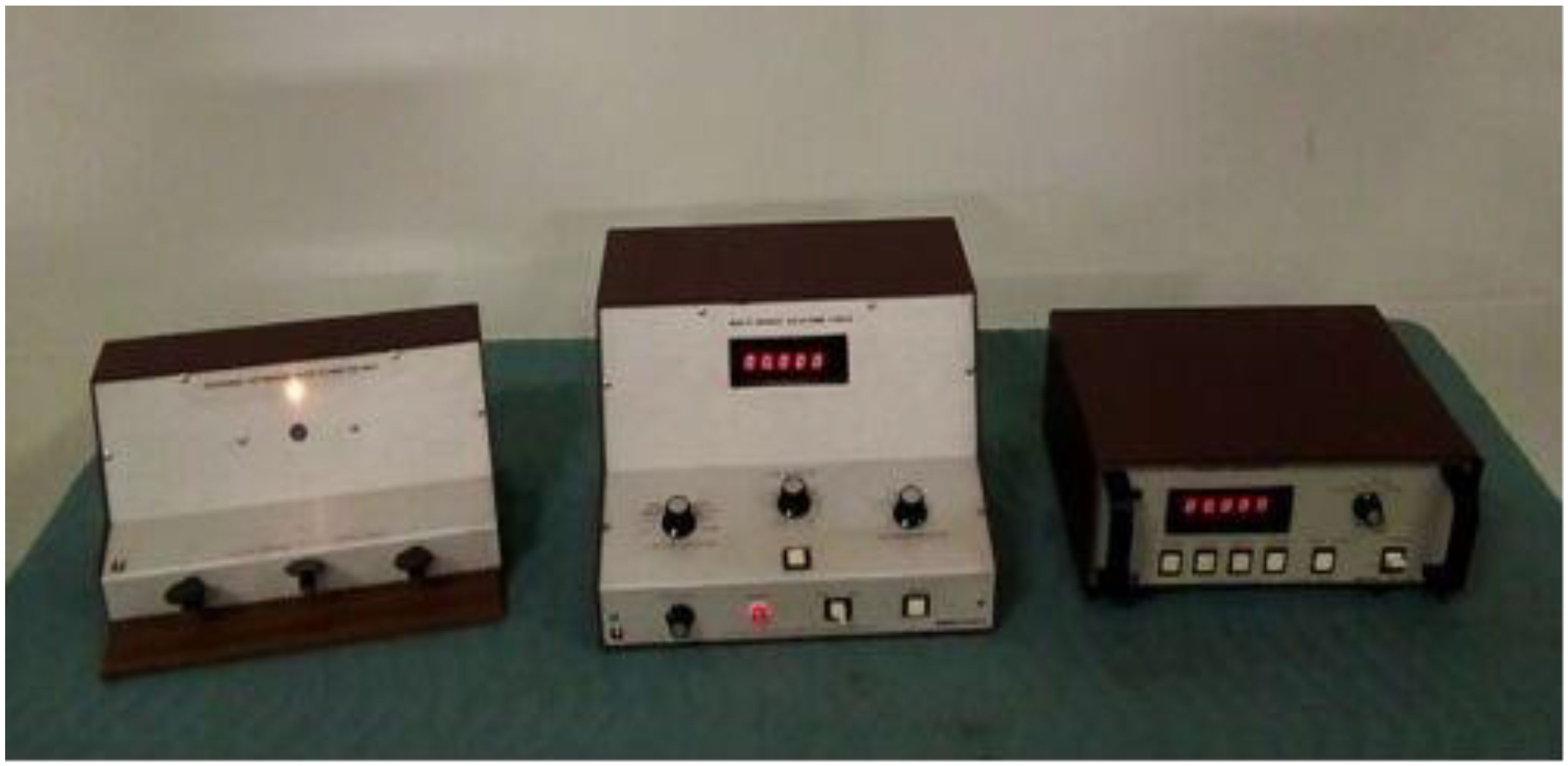
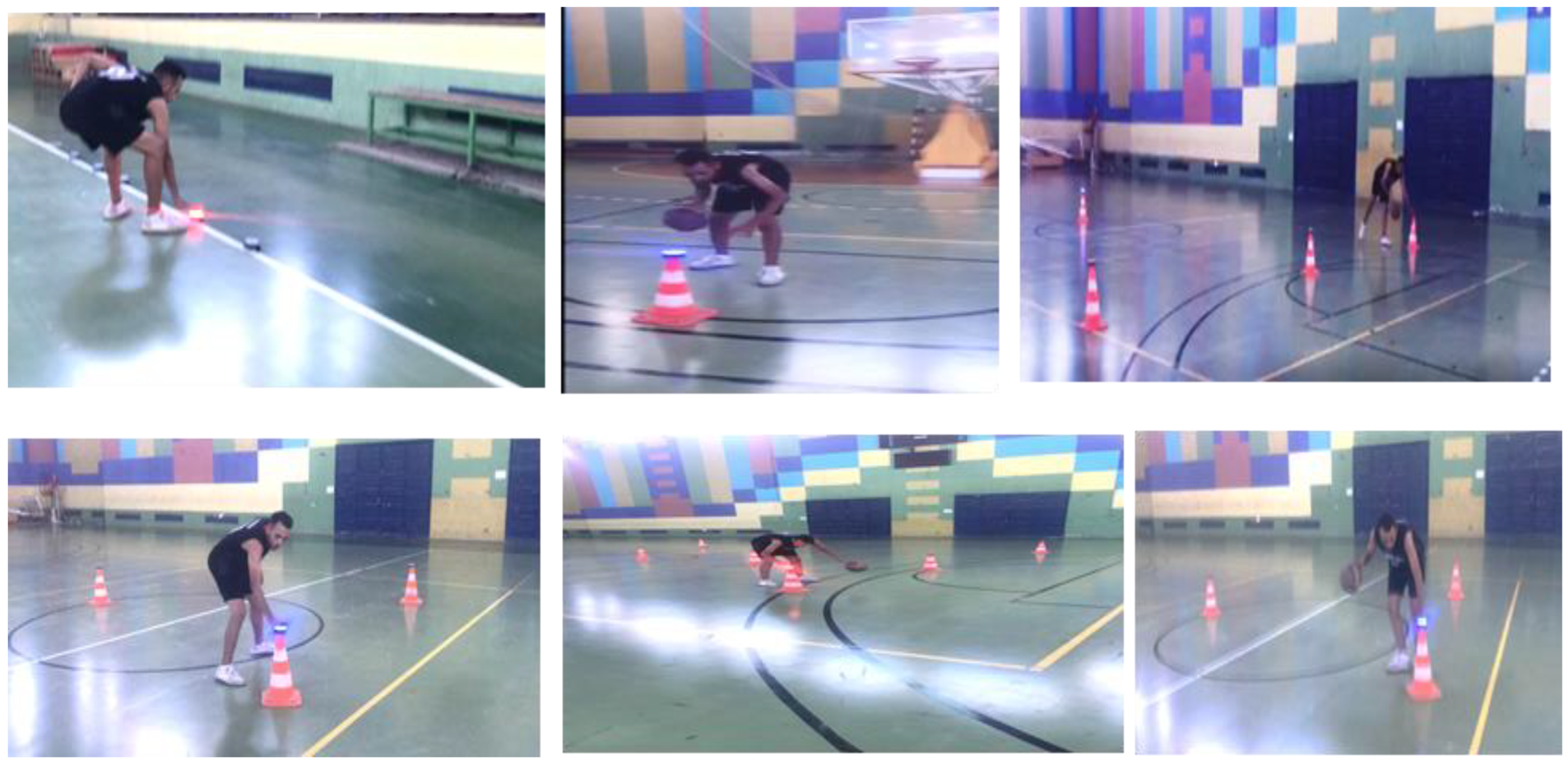
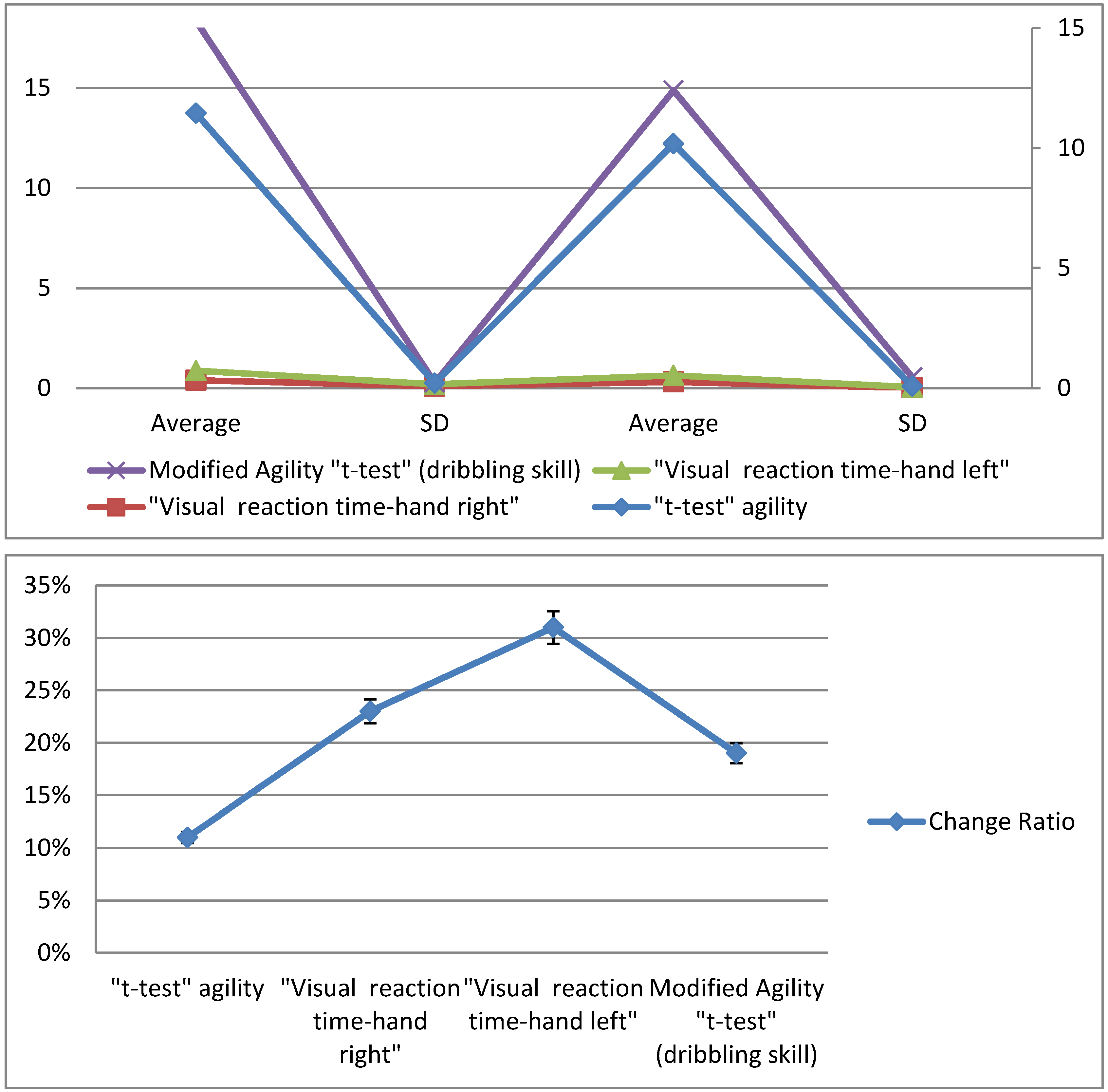
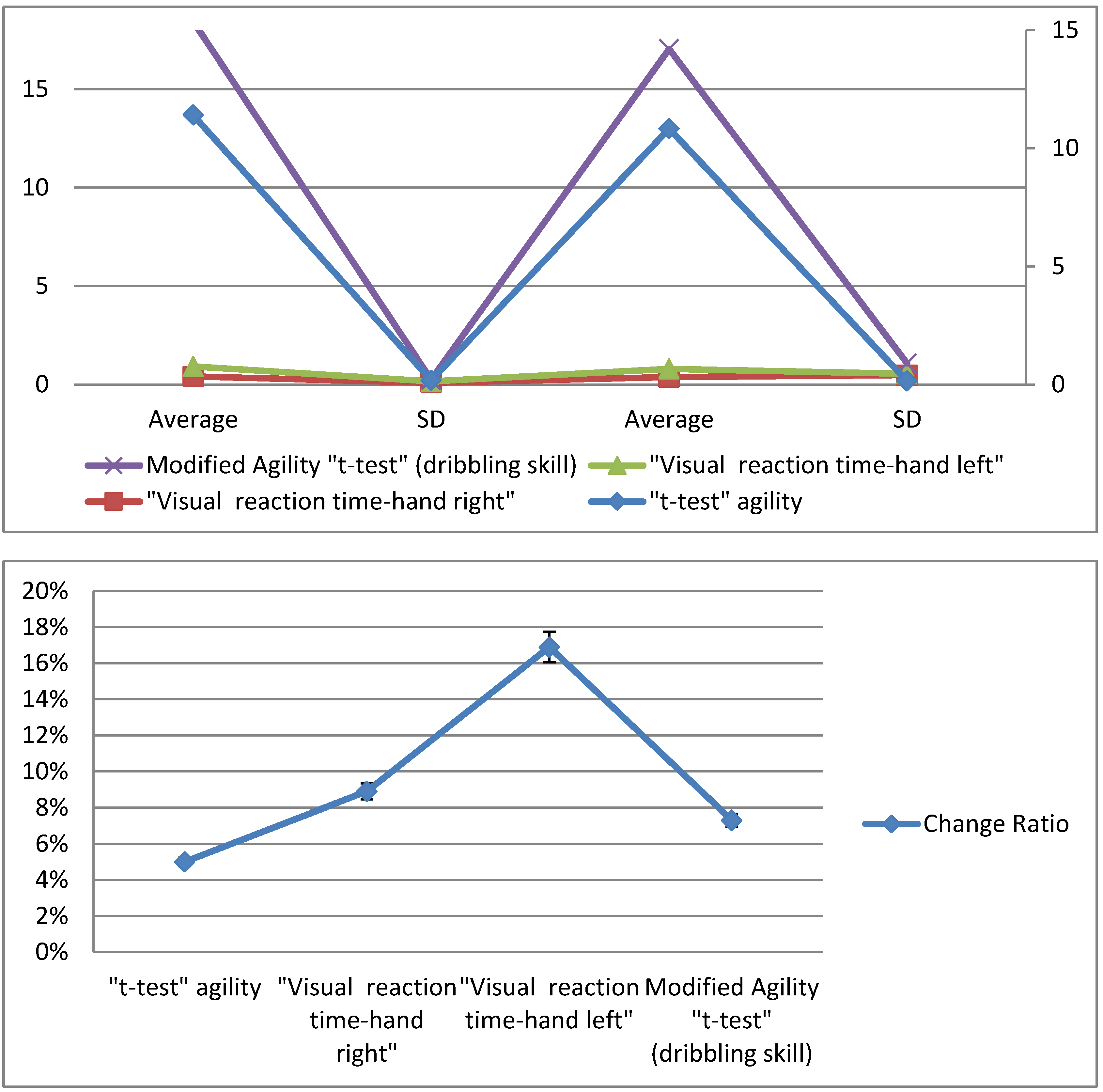
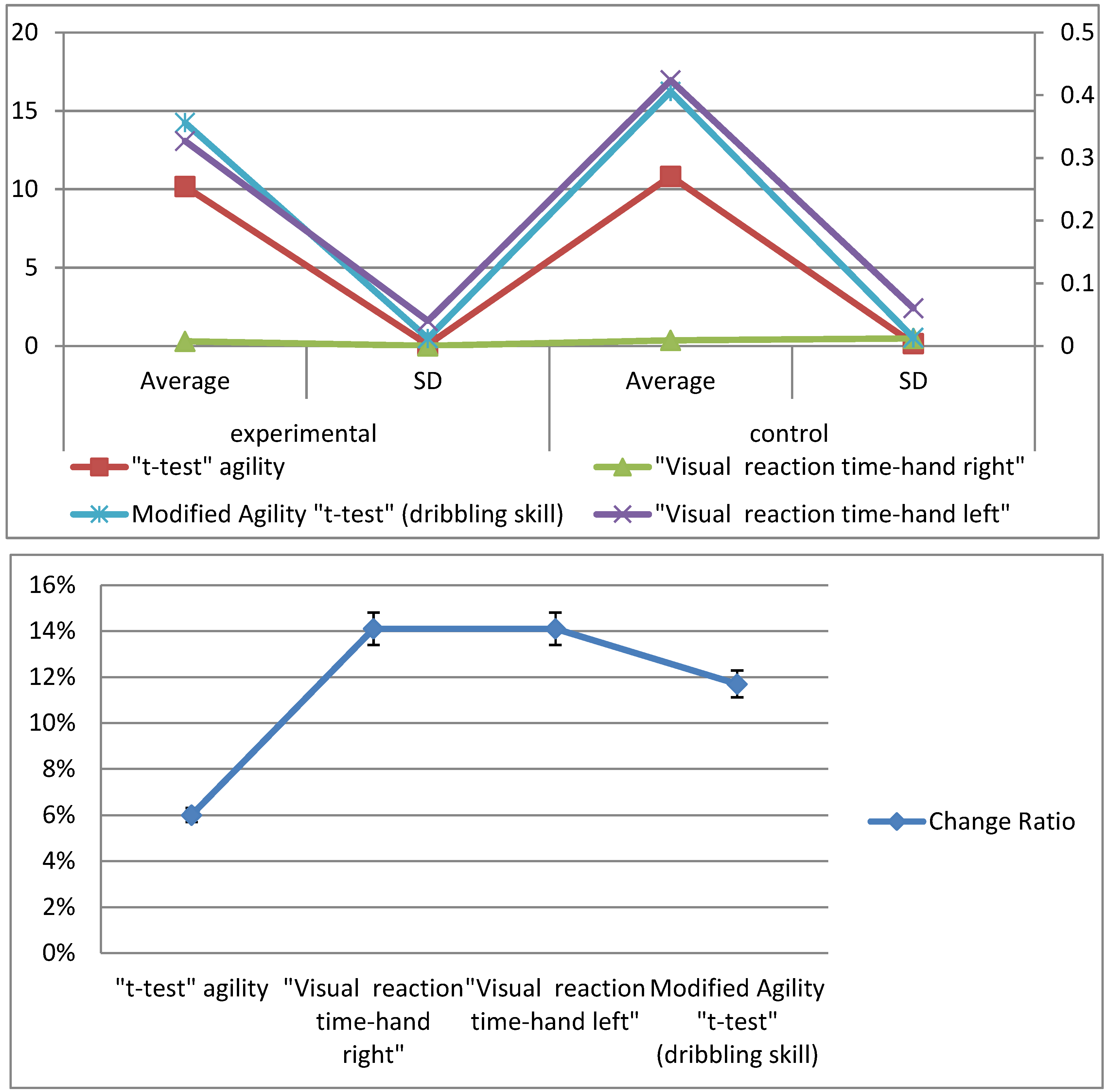
| Tests | Unit of Measurement | Pre | Post | 95% Confidence Interval of the Difference | T | Change Ratio | Sig | |||
|---|---|---|---|---|---|---|---|---|---|---|
| Average | SD | Average | SD | Lower | Upper | |||||
| Agility t-test | s | 11.45 | 0.21 | 10.18 | 0.08 | 1.086 | 1.460 | 15.395 | 11% | 0.000 |
| Visual reaction time—right hand | ms | 0.397 | 0.10 | 0.307 | 0.01 | 0.031 | 0.148 | 3.456 | 23% | 0.007 |
| Visual reaction time—left hand | ms | 0.476 | 0.09 | 0.327 | 0.04 | 0.101 | 0.196 | 7.058 | 31% | 0.000 |
| Modified agility t-test (dribbling skill) | s | 17.49 | 0.08 | 14.25 | 0.49 | 2.867 | 3.610 | 19.756 | 19% | 0.000 |
| Tests | Unit of Measurement | Pre | Post | 95% Confidence Interval of the Difference | T | Change Ratio | Sig | |||
|---|---|---|---|---|---|---|---|---|---|---|
| Average | SD | Average | SD | Lower | Upper | |||||
| Agility t-test | s | 11.40 | 0.17 | 10.83 | 0.15 | 0.450 | 0.670 | 11.151 | 5% | 0.000 |
| Visual reaction time—right hand | ms | 0.406 | 0.09 | 0.370 | 0.48 | 0.002 | 0.070 | 2.379 | 8.9% | 0.041 |
| Visual reaction time—left hand | ms | 0.510 | 0.07 | 0.424 | 0.06 | 0.060 | 0.112 | 7.494 | 16.9% | 0.000 |
| Modified agility t-test (dribbling skill) | s | 17.52 | 0.09 | 16.24 | 0.53 | 0.916 | 1.654 | 7.888 | 7.31% | 0.000 |
| Tests | Unit of Measurement | Experimental N = 10 | Control N = 10 | T | DCR | Sig | 95% Confidence Interval of the Difference | |||
|---|---|---|---|---|---|---|---|---|---|---|
| Average | SD | Average | SD | Lower | Upper | |||||
| Agility t-test | s | 10.18 | 0.08 | 10.83 | 0.15 | 11.981 | 6% | 0.000 | −0.763 | −0.763 |
| Visual reaction time—right hand | ms | 0.307 | 0.01 | 0.370 | 0.48 | 3.079 | 14.1% | 0.041 | −0.535 | −0.535 |
| Visual reaction time—left hand | ms | 0.327 | 0.04 | 0.424 | 0.06 | 4505 | 14.1% | 0.000 | −0.106 | −0.106 |
| Modified agility t-test (dribbling skill) | s | 14.25 | 0.49 | 16.24 | 0.53 | 8.775 | 11.7% | 0.000 | −0.020 | −0.020 |
Publisher’s Note: MDPI stays neutral with regard to jurisdictional claims in published maps and institutional affiliations. |
© 2022 by the authors. Licensee MDPI, Basel, Switzerland. This article is an open access article distributed under the terms and conditions of the Creative Commons Attribution (CC BY) license (https://creativecommons.org/licenses/by/4.0/).
Share and Cite
Hassan, A.K.; Alhumaid, M.M.; Hamad, B.E. The Effect of Using Reactive Agility Exercises with the FITLIGHT Training System on the Speed of Visual Reaction Time and Dribbling Skill of Basketball Players. Sports 2022, 10, 176. https://doi.org/10.3390/sports10110176
Hassan AK, Alhumaid MM, Hamad BE. The Effect of Using Reactive Agility Exercises with the FITLIGHT Training System on the Speed of Visual Reaction Time and Dribbling Skill of Basketball Players. Sports. 2022; 10(11):176. https://doi.org/10.3390/sports10110176
Chicago/Turabian StyleHassan, Ahmed K., Majed M. Alhumaid, and Badry E. Hamad. 2022. "The Effect of Using Reactive Agility Exercises with the FITLIGHT Training System on the Speed of Visual Reaction Time and Dribbling Skill of Basketball Players" Sports 10, no. 11: 176. https://doi.org/10.3390/sports10110176
APA StyleHassan, A. K., Alhumaid, M. M., & Hamad, B. E. (2022). The Effect of Using Reactive Agility Exercises with the FITLIGHT Training System on the Speed of Visual Reaction Time and Dribbling Skill of Basketball Players. Sports, 10(11), 176. https://doi.org/10.3390/sports10110176







